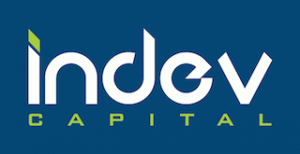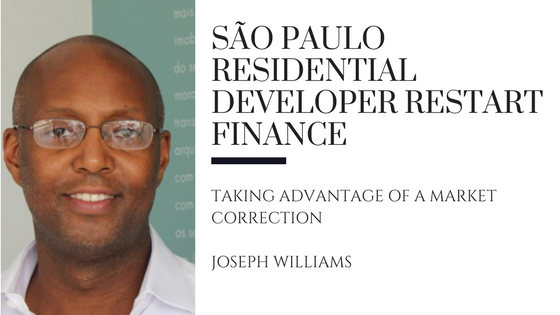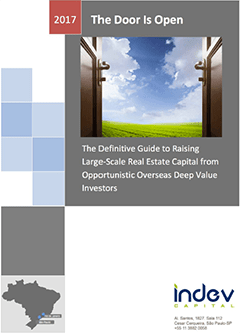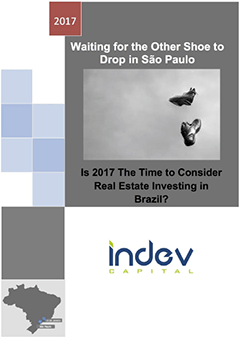.
Introduction
As with most real estate cycles, at one point in time things appear to be perfect. This usually corresponds to a low interest rate environment, strong demand, available land, credit, and suppliers that can execute. Often during these boom times, the first thing one notices is fresh flowers in real estate developers’ offices. In fact, at the peak, one of the largest developers in São Paulo decided that its business model justified a location in the same office building with Google, one of the most profitable businesses on earth. The world was perfect in the for-sale real estate development business in Brazil from 2009 to 2013. It was a vase full of beautiful flowers.
Alas, hindsight seems like 20-20 vision. While demand had been strong in São Paulo for a full decade, the market had not had a significant correction in 10 years. The real estate expansion was largely a result of pent-up demand due to an almost complete lack of credit in the residential real estate ecosystem. In addition, there was a favorable commodity super cycle which benefited Brazil greatly and there was also a 2-year low interest rate environment, not seen in decades. However, there was also a reality in the back of developers’ minds that one day 100% sell outs of all units of a building within hours of a launch would have to end. The pace was not sustainable. The expansion was a very difficult environment in which to maintain underwriting discipline. At the end of the day – the correction began in earnest in 2014 – Yogi Berra’s brilliance rang true. “If the world were perfect, it wouldn’t be….”
When the market corrected in 2015 and 2016, significant profits had already been rolled into various projects that all hit the market at exactly the wrong time. The effects were catastrophic for many developers. Currently, most developers simply do not have the capital to start over; some will fail and leave the market.
.
The Investment Opportunity
This shift and the change in the São Paulo residential market create a unique investment opportunity. Developers face a very different reality; negotiating leverage strongly lies with the investor. Core demand in São Paulo exists; however, it is critical to look at the market with a very discerning eye. It is also crucial to become hyper selective about the quality of the partner and the quality of the projects.
What’s the difference now versus then? Now an investor can select the best projects, coupled with strong micro regional demand, executed by the best developers who will accept terms unthinkable earlier in the cycle. Think of it as developer Re-Start finance with a land buy in price set at a significant discount. Basically, a chance to invest and dictate your cost basis on land already purchased. How did this happen?
.
Purpose of this Document
This document’s objective is to provide investors with a clear picture of a unique investment opportunity at this time in São Paulo’s residential construction market. The core of the investment thesis is the following: one, there are micro-regions of demand where the supply of product does not meet the demand criteria of the customer; two, the best development partners are available currently and investments executed with proper incentive and top-tier asset management can produce significant investor profits; three, investments can be structured to the investor’s strong advantage with 25%+ nominal IRR returns with conservative underwriting.This is possible due to the “in-the-money” buy-in price.
This document will provide a history of how we arrived here, a perspective on São Paulo as a target market, a discussion of the downturn and the core caution lights, case studies of success and failure in the new market environment, lessons from those case studies, and a detailed how-to for an investor to move forward.
.
São Paulo, Brazil and Core Demand
.
About São Paulo
Brazil’s business headquarters and wealth center is centered in São Paulo. The city of São Paulo alone represents 12% of Brazil’s GDP while only representing roughly 5.5% (12,106,920 people in 2016) of the country’s population. The São Paulo metropolitan area creates 19.6% of Brazil’s GDP while only representing roughly 10.6% (21,242,939 people in 2016) of the population.
São Paulo serves as the heart, the central decision-making location, and the engine for Brazil’s economy, hosting Latin America HQs of 65% of Fortune 500 companies. It is the largest financial center in the southern hemisphere and is the main host city of events in Latin America. It is hard to overstate the importance of the city of São Paulo to Brazil’s economy.
São Paulo is also known as one of the most important multicultural centers in the world. The city hosts the largest Japanese, Italian, and Lebanese communities, outside of those respective countries, in the world.
.
History of the Market
To fully understand the dynamics of this developer re-start finance opportunity, one must go back in time. São Paulo has been one of the largest cities in the world for decades. Therefore, there has always been latent demand for housing. However, until 2006 the market was constrained.
- Start of the Mortage Market
- Credit Market Statistics
- Strong Net Family Formation in São Paulo
- Price Appreciation
- Expansion Creates Developer Mistakes
- Top 9 Mistakes Made by Developers During the Expansion
- Fatal Errors and Deadly Inventory
- The Downturn
- Caution Lights to understand about São Paulo Downturn
- Going Forward / Key Factors in the New Normal
.
Evolution of Investment Opportunity
To understand the type of opportunity that exists, it helps to think about how the cycles have played out in the market. The residential market as we know it in São Paulo and Brazil really began in 2006 with the advent of residential mortgages. Hence, the latent demand was quite large earlier in the cycle. While there are distinct opportunities, the market now requires intelligence about the real estate cycle. The true story below provides a look into how the opportunity presents itself in the market.
- Developer Example of Pre and Post Downturn: The Case of Father and Son (multiple cases in São Paulo)
The core difference between developers who come out of the downturn successfully and those who do not is the discipline to secure and properly acquire high-quality land sites – this is the most important factor of a successful real estate developer. If a developer pays too much for the land, even if it is well located, nothing can be done to recoup the investment. If a developer pays a good price for a bad piece of land, that too is worthless. During the boom cycle, many less experienced developers lost this crucial land purchase discipline and results have clearly delineated the market to one of the survivors about to take advantage of the next cycle and those that will exit the market.
Experience – To maintain price discipline and tight underwriting during the boom cycle was very difficult, even more so if you were a public company managing the push by equity analysts to purchase land and to launch projects to maintain a high market valuation. Only the most experienced developers maintained this rigor when actual sales prices were consistently above their cautious underwriting. Experience through cycles both up and down, prior to 2006, provided this perspective.
Execution – During the real estate expansion from 2006 to 2013, many projects were delivered late and/or over budget. The ability to maximize profits during the upturn corresponded to the ability to limit losses and survive the downturn. This ability to execute in various market conditions is paramount.
Focus – During the expansion, it was important that the developer had experience with the targeted product type, region, and type of customer or moved forward cautiously to source an experienced JV partner or built its internal expertise in the target market or product group. Rapid expansion of scope led to significant losses.
Team – Management teams that have been together during various cycles tend to stay together and pull through the various situations that can occur. These survivor developers tend to grow only where their management talent development will allow them to manage. In contrast, in a very tight labor market, in 2011, 2012, 2013 many new management teams of developers hired junior engineers as project managers. These new members of the team often had real P&L responsibility with no relevant experience or sufficient training, particularly outside of São Paulo. In addition, these engineers and project managers didn’t have the experience to approve, develop, and manage multiple projects simultaneously. As a result, costs exploded and terms of construction and delivery targets were not accomplished. Often, it was a mild disaster at best.
.
Case Studies
The two case studies below provide a perspective of the real estate market in São Paulo. To understand the market one first needs to understand the market’s core demand, covered in our first case study, and then understand how the current real estate market in early 2018 compares to the market in 2009 right after a downturn, covered in our second case study.
- Case Study – Successful Project in 2016, Toughest Part of the Downturn
- Taking Advantage of the Real Estate Cycle – São Paulo Brazil
.
Expansion Period versus Current Market Comparison
The days of launching project after project in São Paulo with first weekend sales of 60-80% and ever-climbing prices are behind us and likely not coming back. Developers, albeit reluctantly, will eventually realize that the slower sales speed is not temporary but rather a “new normal.” This changes the developer’s business model and equity cash needs significantly. The change in the market has significantly altered the behavior of market participants, as outlined in the Stakeholder Behavior Analysis section below.
.
Developer Re-Start Finance Investment Strategy
An investor interested in this high risk-adjusted return investment strategy needs to carefully evaluate the opportunity from various perspectives. The six key areas of analysis are the following:
- Micro Subregion Analysis
- Product Analysis
- Replacement Cost Analysis
- Zoning Analysis
- Developer Analysis
- Comparable Projects
.
Execution Best Practices
Even with the best crafted plans, it all comes down to execution. This re-start finance investment strategy must include a clear focus on excellent execution of marketing and sales, management of construction costs, and customer credit evaluation.
.
Investor Economics in Today’s Market in For-Sale Residential Development
For investors at this time in the cycle, selecting well-executed projects can still produce attractive returns; however, it is important to deeply understand the economics of the project and the incentives of the developer. The investor needs to arrive at the negotiating table with detailed information and a firm initial purchase price in mind, an IRR return hurdle. Investor preparation will include replacement costs analysis, market comparisons, and an understanding of how zoning affects supply.
Developers simply do not have the capital to restart their engines. The large majority of remaining landowners are well capitalized wealthy families and are patient to wait for the next cycle or to sell for at least a fair market price. Rarely does one see distressed sales on land sites in top-tier neighborhoods.
Hence, as many developers bought land at or near the peak, the buy-in price for an investor currently will be dilutive to the developer’s equity position. To source capital to turn their land banks into cash, developers must work with a promote structure and receive a reward on the back end. While this is not their ideal, this is the brutal reality of their situation. The ideal investor structure will be a preferred equity-like structure with equity upside.
Currently, the banks demand 40% of units sold before the start of construction financing. Without a significant equity cushion, developers have to reduce prices to the point of killing profits to achieve this number rapidly. This investor capital injection allows developers time to sell in a disciplined way. This reduces developer risk and importantly provides the change to create profits to restart the economic cycle.
.
Deal Structure
The best method to structure transactions in this environment is a preferred equity position. The investor would receive the principal first, after that the developer receives his principal, and after that profits are split proportionally. The successful execution of this strategy will likely result in a purchase of between 25% to 50% of the project’s equity along with extremely rigorous governance.
The entry point calculation will be done through conservative underwriting of the project’s sales price, sales speed, time of construction, cancellations, etc. It is suggested the investor use a present value method to determine entry price and therefore the percentage of participation based on the size of capital committed. Of course, the exact deal structure of the acquisitions will be decided on a case-by-case basis.
In all cases, the target is a 25%+ IRR nominal return.
.
Next Steps and Summary
The best residential real estate development opportunities are usually the result of purchasing land at the right price and starting development in an improving economy. Ideally most of the sales occur when the market is in a substantially improved situation as compared to when the land was purchased.
For deep value investors, the Brazil Developer Re-start investment strategy is particularly appealing. Why? It is not necessary to purchase at the bottom of the market to achieve “bottom of the market prices.” The São Paulo residential market is already 10% to 15% stronger than it was at the bottom. However, the buy-in basis can be similar to prices in 2016.
This arbitrage is achieved through market intelligence of a local co-investment partner combined with the fact that developers do not have sufficient capital due to the result of the recent economic downturn.
As investors evaluate strategies to take advantage of Brazil’s economic recovery, this developer re-start strategy is one of the best options. Importantly, this strategy requires choosing the right developer partner(s), understanding how to evaluate the potential real estate projects, and understanding the nuances of the customer demand.
For investors interested in meeting local co-investors with significant expertise that are currently executing this strategy, please reach out to Joseph Williams at joseph.williams@indevcapital.com to set up a call.




